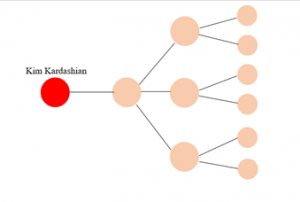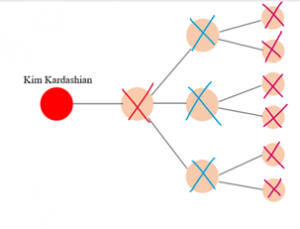The Kardashians and Diffusion
The Kardashian family is a household name across the US and even around the world. Known for their reality TV show, Keeping Up with the Kardashians, their social media platforms, and for their drama, the family has always been on the receiving end of scrutiny and attention. As of December 2020, Kylie Jenner is the 5th most followed Instagram account with over 201 million followers. Not far behind is Kim Kardashian, in 7th place with over 192 million followers (1). Combined, the Kardashian sisters — Kourtney, Kim, Khloe, Kendall, and Kylie — have amassed over 763 million Instagram followers, and including their mother Kris, the family has over 800 million followers on the app. In addition, the Kardashians also generate huge amounts of interaction with their posts. For example, Kylie Jenner’s first post with her daughter on February 7, 2018 is the 5th most liked post on the app, with 18.5 million likes. Jenner also holds the 8th, 11th, 14th, 17th, and 20th spots (2). Thus, combined with other social media platforms, such as Snapchat and TikTok, the family has a huge amount of influence, especially on younger people who interact with their posts and see their actions on social media. The question then arises: how has this influence affected America, especially for young people?
First, we analyze their influence in terms of products they have advertised on their social media platforms, through the lens of diffusion on social networks. One of the most popular products the Kardashians have promoted on their Instagram accounts is Function of Beauty customizable shampoo and conditioner. On February 20, 2020, Kim posted an ad for the brand on her Instagram, a post which currently has 1,387,758 likes and over 7,500 comments. To consider the scope of this audience, we take an example network of one of Kim’s followers. We assume, for example, that this particular follower of Kim has 3 friends and that each of these friends have 2 additional friends.
If this follower switches from their current shampoo brand to Function of Beauty as a result of seeing Kim’s post about the brand, this can potentially cause a cascade through the entirety of this follower’s social network. To further consider this event, we consider several options for the threshold q, where if the number of neighbors using Function of Beauty shampoo is > q, then that node will also switch to using Function of Beauty shampoo. If, for example, just 1 of Kim’s followers switched to using Function of Beauty because of her post, this would mean that q = 1/192000000. By the principle of diffusion, this would cause a complete cascade of switching to the new product, which can be seen in the figure below. On the first step (shown by red x’s), Kim’s direct follower would switch to the new product. On the next step (shown by blue x’s), because for any one of this follower’s friends q > 1/192000000, so each of the friends will switch. The same holds for the next level of this tree (shown by pink x’s), and thus, a complete cascade would occur on this social network.
However, a q of 1/192000000 is unrealistic, considering the immense size of Kim Kardashian’s following. Thus, we consider if q = ¼ of a node’s neighbors have switched to the new product, that node will switch too. On the figure below, the direct follower of Kim will swtich to using the new product because 1 out of their 4 neighbors has switched; this threshold is greater than or equal to q, so the follower will switch (shown by the green x). Then, for each of this node’s neighbors, 1/3 of their neighbors have switched to the new product, so since 1/3 > ¼, this node, too, will switch (shown by purple x’s). Finally, for the last set of neighbors, each of these nodes has only 1 neighbor, and that neighbor has switched to the new product, so since 1 > 1/4, each of these nodes will also switch (shown by blue x’s). So, q = ¼ also causes a complete cascade on this example network.
In order to not have a complete cascade on this example network, q would have to be greater than ¼, because then the first node would not necessarily switch to using the new product. This, of course, also depends on the number of neighbors each follower has. In addition, because Kim has hundreds of millions of followers, even if a small percentage of her followers adopt her actions, this still accounts for a large population.
The question then arises: can this kind of easy diffusion ever be harmful? The American Society of Plastic Surgeons found that the answer is actually yes (3). According to their study, the Kardashians have contributed, in at least some way, to a growing number of young people getting plastic surgery or other appearance-altering procedures. In 2014, 64,000 patients were ages 13-19; in 2015, 64,470, were ages 13-19, with an additional 161,700 less invasive procedures performed that year. Because nearly all of the Kardashian family members have undergone some kind of cosmetic procedure, and because these procedures and their effects are glamorized and presented to their large audiences, it makes sense that they have influenced an increase in the number of people who want these procedures for themselves. Through the lens of diffusion, it would make sense that the q value threshold is probably lower for these kinds of products or purchases – people may need to be influenced by multiple celebrities in order to get a cosmetic procedure done but they may buy a shirt or perfume if just one celebrity endorses it.
Thus, in a society constantly influenced by celebrities and their social media platforms, diffusion is inevitable into the lives of “normal” people.
(1) https://www.statista.com/statistics/421169/most-followers-instagram/
(2) https://en.wikipedia.org/wiki/List_of_most-liked_Instagram_posts
(3) https://nypost.com/2017/09/23/how-a-decade-of-the-kardashians-radically-changed-america/



